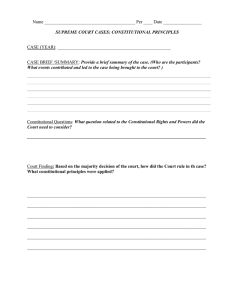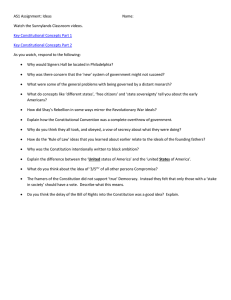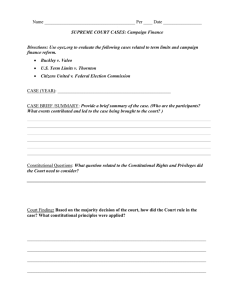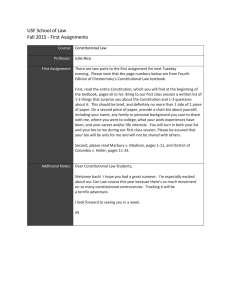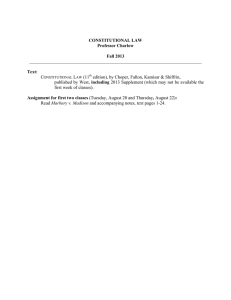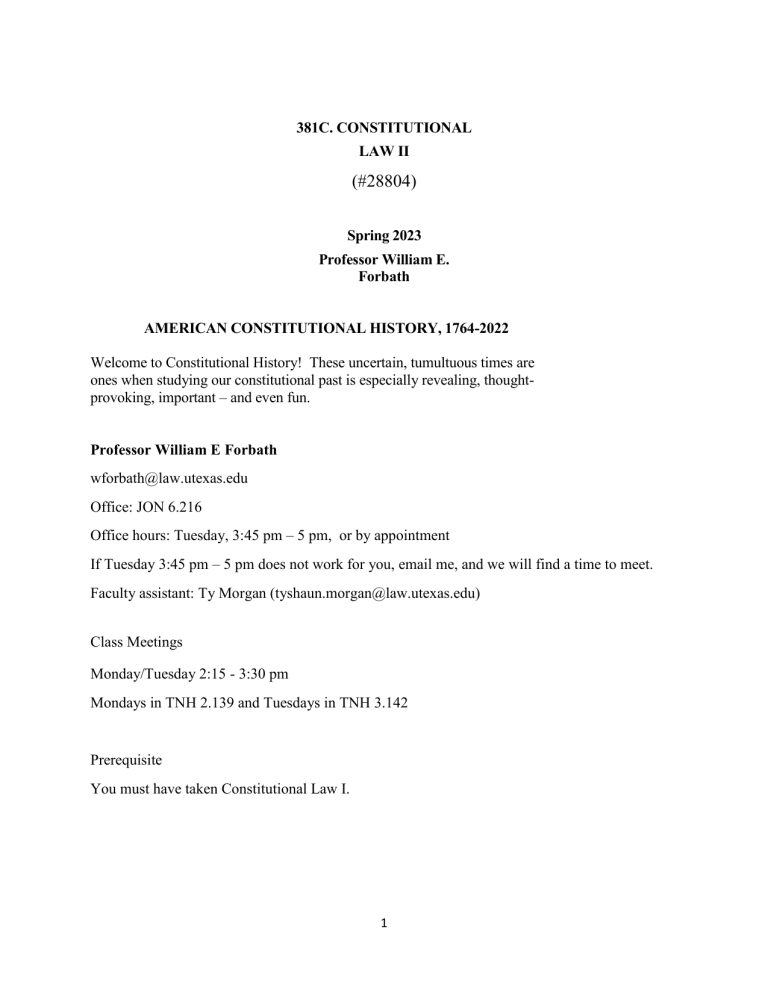
381C. CONSTITUTIONAL LAW II (#28804) Spring 2023 Professor William E. Forbath AMERICAN CONSTITUTIONAL HISTORY, 1764-2022 Welcome to Constitutional History! These uncertain, tumultuous times are ones when studying our constitutional past is especially revealing, thoughtprovoking, important – and even fun. Professor William E Forbath wforbath@law.utexas.edu Office: JON 6.216 Office hours: Tuesday, 3:45 pm – 5 pm, or by appointment If Tuesday 3:45 pm – 5 pm does not work for you, email me, and we will find a time to meet. Faculty assistant: Ty Morgan (tyshaun.morgan@law.utexas.edu) Class Meetings Monday/Tuesday 2:15 - 3:30 pm Mondays in TNH 2.139 and Tuesdays in TNH 3.142 Prerequisite You must have taken Constitutional Law I. 1 THE SUBJECT OF CONSTITUTIONAL HISTORY & OUR GOALS FOR THE COURSE Constitutions are about power, what it is to be used for, by whom, and according to what understandings and justifications. Constitutional conflicts concern the reach and limits of government power: state and local power versus federal power; legislative versus judicial power; public governmental power versus private liberty. Constitutional conflicts, at the same time, concern questions of interpretive authority. Who has the right to say what the Constitution means and demands? The courts? The President? The federal or state lawmakers? The people themselves? Constitutions, also, are about political community. Who belongs, in the U.S. Constitution's words, to "We, the People"? Who counts as a full, rights-bearing citizen? And what are his or her rights? These are the main issues of constitutional history; small wonder that its currents and conflicts have involved more than the courts. This course will weave together U.S. constitutional history in the courts with the history of constitutional conflicts in American politics, culture and society. One of our goals will be to equip you to think deeply and argue clearly about today’s constitutional conflicts, in the light of the ways that such conflicts have unfolded in the past. At the same time, we will explore the uses of history in constitutional interpretation. What kind of authority should past generations’ constitutional understandings and commitments enjoy in today’s constitutional contests? What does it mean to be “faithful” to the Constitution as a centuries-old text and a centuries-long experiment in self-government? In what ways are we bound by the words and deeds of the past? In what ways are we free to construct new constitutional meanings and principles? These are questions which arise in constitutional litigation. Even more often, they arise in constitutional discussions, arguments, and debates outside the courts – in electoral, legislative and administrative arenas and in public discussion and debate. Never have these questions been more pressing than today, when, in one way or another, “we are all originalists,” as Justice Kagan famously put it. So, now more than ever, these are questions which fellow citizens will expect you as a well-educated lawyer to help them understand. Another goal of this course will be to equip you to address these questions with a deep understanding of how past generations addressed them – and to acquaint you with the strengths and limitations of standard forms of “originalism.” You will learn to make sophisticated arguments in an “originalist” framework, and also be able to address the shortcomings of that framework. We will focus chiefly on the first century of American constitutional experience. We will examine the founding of the republic and the framing and Antebellum history of the Constitution as a great experiment in self-government and a great set of struggles over race-based human bondage. A key goal here will be to equip you to discuss how the founding generation and the ones that followed it understood the meaning of key constitutional provisions--and how they 2 understood the roles of ordinary citizens, lawmakers, and the Executive, as well as courts, in resolving disputes about constitutional meaning. We will also study the same period as a great constitutional experiment in federalism - in creating and managing a union of states with profoundly different social orders, values, and interests. It is impossible, in our constitutional tradition, to construct well-informed views about the subject of federalism – and today’s conflicts over the respective powers and limits of state and national government – without a fairly deep understanding of federalism’s past. So, another goal will be to equip you with such an understanding. One main theme in our study of federalism will be the protracted conflicts and accommodations between North and South and Free Labor and Slavery. The coming of Civil War repays careful attention because the Civil War remains the most important constitutional crisis in our history. The War and its aftermath, the period known as Reconstruction, and the Civil War and Reconstruction Amendments (13th, 14th, and 15th Amendments), constituted a Second Founding, no less significant than the first. The authority of the national government over the states was transformed, and with it, the meaning of American democracy. From a slaveholding, racially exclusive republic, America reconstituted itself into a racially inclusive republic of equal citizens. We will study this Second Founding, then its unraveling in the constitutional law and politics of the late 19th century, and then its revival in the Civil Rights era of the mid-20th century. As a particularly rich entry point into the uses of history in constitutional interpretation and the uses and abuses of originalism, we will devote some time at the beginning of the semester to current controversies over gun rights – as well as a glimpse at the controversy sparked by the Supreme Court’s recent use or abuse of originalism in its decision overturning Roe v. Wade last term. READING MATERIALS, READING ASSIGNMENTS All our readings this semester will be in two volumes of materials that I have prepared for this course. Volumes I and II are posted on CANVAS under Files. Each of the several sections of Volumes I and II are found as separate PDFs; each volume is also posted as a single long PDF file. I will be providing you with “Reading Assignments - Notes & Questions” for every class, and these notes and questions will help guide your reading. For some classes, I also will include “Debate & Role-Playing Assignments.” These Notes, Questions, Debate and Role-Playing Assignments will be emailed to you (using CANVAS) every Tuesday evenings, for the following week’s Monday and Tuesday class meetings. They will also be posted in the Files section of CANVAS. Reading assignments will range from 20-50 pages per class. The shorter assignments will consist of cases and primary sources; the longer ones will consist chiefly of historical narratives. Remember, reading historical narrative is very different from the equivalent amount of legal or law review material. You should be able to grasp the events and issues at hand, the author's 3 argument and supporting evidence, as well as her insights and passions -- and maintain a considerably faster pace than you do reading case law. Reading primary sources like political speeches and political pamphlets with an eye for the often rich and sustained constitutional arguments they contain involves somewhat more detailed work. You will want to examine how the speakers and authors weave together immediate legislative or campaign issues with constitutional claims. What kinds of constitutional authority (text, precedent, history, structure, and so on) and what kinds of constitutional-historical narratives do they employ? And how do these differ – and not differ - from constitutional arguments in the courts? Even when an assignment consists of judicial opinions, you should not read them as though this were a course on contemporary law. Your task is not doctrinal mastery. Try to figure out what is at stake – politically, socially, economically, and ideologically – in the case. Also try to identify the main contours of doctrine and underlying norms or principles, the key sources of constitutional authority (precedent, history, structure, and so on), the key rhetorical moves and the ambiguities and evasions, if you can. And also ask yourself what the cases reveal about the broader conflicts and changes surrounding them, and the worlds and ways of life out of which the opinions emerge and about the judges' and lawyers' understandings of, and relations with, those worlds. How we will read and explore cases and other legal materials will emerge clearly after a few classes. Also, the Notes and Questions I supply in the “Reading Assignments - Notes & Questions” for each class will greatly help to guide your reading. CLASS ATTENDANCE, PARTICIPATION, RULE OF MUTUAL RESPECT & PROHIBITION ON RECORDING Students will be expected to prepare for, attend, and participate in class discussions, mock debates and other role-playing experiments assigned in advance of individual classes. In the event that you will be unable to attend, or in the event that you will have to attend class unprepared, please email me in advance. I strongly prefer that you attend class even if you have not prepared, so I would encourage you to come to class, but email me in advance; I will not call on you. Note: If you are absent or unprepared on more than a few occasions, I reserve the right to factor that into your final grade. The Law School policy on the subject of class attendance is: Law School’s Attendance Policy. In addition, I expect all of us to treat one another with mutual respect and consideration. I often will ask students to take sides in debates and arguments, which are bound NOT to match up with their personal views and values. Such role-playing is a valuable part of studying the past. It only works if we bear in mind that we are exploring the past and not treat one another as though we were personally attached to the roles we take up. 4 For similar reasons of mutual respect and the free exchange of ideas, I hereby forbid students from recording class discussions. Any recording of classes will be done by me and my assistants for use approved by me and the administration. WEEKLY “ASSOCIATES,” THEIR RESPONSIBILITIES & WRITING ASSIGNMENTS in form of “RESPONSE PIECES” Each week (starting Monday, January 23), a group of roughly 4 or 5 students will be assigned as “associates.” Every student will be an “associate” two times during the semester. By Tuesday evening, January 17, Mr. Morgan and I will prepare and post on CANVAS under Files, a Schedule of “Associates” Assignments for the semester. We will also email the Schedule to each of you via CANVAS. The burden is on you to inform Mr. Morgan (tyshaun.morgan@law.utexas.edu) no later than 9 a.m. on Tuesday, January 17, if there is any particular week when you will NOT be able to participate as an Associate. Associates have two different kinds of responsibilities. 1. Associates must be prepared to be especially keen discussants, discussion leaders (we will occasionally break up and have small group discussions), debaters and roleplayers. That means they should be prepared to address the questions I raise in my Notes & Questions and to single out what seem to them key issues. On days when I assign everyone to prepare to take part in a mock debate (e.g., about whether or not to ratify the 1787 federal Constitution), and assign roles in that debate, I will expect Associates to be especially well prepared and to take leading roles in the debate. 2. Associates will be required to write two short (roughly 300 to 400 word) response pieces – one per week for each of the two weeks in which they are assigned to be associates. The response piece will be a written response to one of the Questions I pose in the “Reading Assignment - Notes and Questions” for the Tuesday class of the relevant week. In the Reading Assignment, I will indicate the particular Question that Associates will have to address in their response pieces. The response pieces will be due no later than 6 p.m. on Monday evenings. You will post your response piece on the Discussion section in Zoom, under the relevant week (e.g., “Response Pieces for Tuesday, January 24”). Everyone should read their fellow students’ response pieces before the Tuesday class. I will provide comments on your response pieces, and I will post those comments in the Reply box in the Discussion section, so everyone has the benefit of my comments. Your response pieces also will be graded, but I won’t be posting the grades. I’ll email the grade to you. For purposes of your final grade, I will factor in the higher of the two 5 grades you receive on your response pieces. (See below for further discussion of grading.) GRADING, FINAL EXAM As noted, students will receive grades on their two response pieces. The higher of your two grades will count as 15% of your final grade. The remaining 85% of your grade will be based on your final exam. Students also will receive a grade for class participation, with particular attention to your weeks as an associate. However, this grade will not be averaged into your overall final grade UNLESS it will give your grade an upward boost. If so, it will count for 20%, with the response pieces and exam counting proportionately less. The final exam will be a “floating” 24-hour take-home exam, with two essay questions with strict word limits. In the FILES section of CANVAS, I have posted examples of past 24-hour take-home exams for this course with the identical format, and also an assortment of first-rate exam answers. The exam will be administered by the Student Affairs Office using Exam4. You may choose when to begin the exam anytime during the regular final exam period. All floating exams should be completed no later than the second Thursday of the exam period at 4:30pm. This semester that will be Thursday, May 4 at 4:30 pm. Student Workload This course complies with the Law School’s Credit Hour Policy and will require at least 42.5 hours of total student work per credit during the semester (including the final exam period). Classroom Safety and COVID-19 The University provides guidance and information to help us preserve our in person learning environment. 6 Accessibility Statement The Law School is committed to creating an accessible and inclusive learning environment consistent with university policy and federal and state laws. If you are a student with a disability, or you think you may have a disability, and may need academic accommodations, please contact the Division of Diversity and Community Engagement, Disability and Access (D&A) for information and assistance. If you are already registered with D&A, please deliver your Accommodation Letter to the Student Affairs Office as early as possible in the semester to arrange your approved accommodations. If you have accommodations for exams, arrangements must be made with the SAO at least a week before the exam. Because the Law School operates primarily on an anonymous grading system where possible, academic accommodations are coordinated through the Student Affairs Office. Faculty members are included in the process only when needed to implement classroom accommodations. (See next page for page numbers for the readings) 7 VOLUME I I. INTRODUCTION: HISTORY AS AUTHORITY AND HISTORY AS A WAY OF UNDERSTANDING CHANGE AND CONTINUITY – SITUATING OURSELVES IN RELATION TO THE CONSTITUTIONAL PAST Heller as a Case Study in “Originalism” District of Columbia v. Heller, 554 U.S. 570 (2008) ....................................................... 1 District of Columbia v. Heller (Stevens dissenting) ...................................................... 10 District of Columbia v. Heller (Breyer dissenting) ........................................................ 17 Reflecting on Originalism and the Uses of History Excerpts from Reva B. Siegel, Dead or Alive: Originalism as Popular Constitutionalism In Heller, 122 HARV. L. REV. 191 (2008) ................................................................. 21 Antonin Scalia, Originalism: The Lesser Evil, 57 U. CIN. L. REV. 849 (1989) ............ 35 Jack M. Balkin, Living Originalism (2011) 3-12, 16-20 ............................................... 40 A Glimpse at Originalism on Today’s Supreme Court and in the Lower Courts – and at Professor Siegel’s Reaction to Dobbs Reva B. Siegel, The Trump Court Limited Women’s Rights Using 19th Century Standards, THE WASHINGTON POST, June 22, 2022………………………………….51A N.Y. State Rifle & Pistol Assoc’n v. Bruen, 597 U.S. __; 142 S.Ct. 2111 (2022) -The Trump Court’s “History Only” Reading of Heller…………………………….………………………51D Bruen in the Lower Courts – a Texas case involving a federal bar on gun possession by persons under state court restraining orders for domestic abuse – U.S. v. Perez-Gallan, 2022 U.S. Dist. LEXIS 20758 (W.D. Tex.2022)………………………………………………………………51F II. REVOLUTION AND THE EMERGENCE OF THE IDEA OF POPULAR SOVEREIGNTY AS THE BASIS OF LAW James Otis, “The Rights of the British Colonies” (1764) .............................................. 52 8 Material on Writs of Assistance ..................................................................................... 54 Source: Stephen Presser and Jamil S. Zainaldin, eds., Law and Jurisprudence in American History (7 th ed., 2009) 65-91. Farah Peterson, Black Lives and the Boston Massacre… ..............................................82 Source: The American Scholar (Winter 2019) Hiller Zobel Response, Peterson Reply .........................................................................97 Source: The American Scholar (Winter 2019) Thomas Paine, “Common Sense” (1776) .................................................................... 101 Introduction from: Melvin Urofsky and Paul Finkelman, eds., Documents of American Constitutional and Legal History, Vol. 1 (2nd ed., 2002) 45. The Declaration of Independence (1776) .................................................................... 106 III. REPUBLICAN STATE CONSTITUTION-MAKING Virginia Constitution (1776) ........................................................................................ 109 Pennsylvania Constitution, with introductory note (1776) .......................................... 115 Note on Early State Constitutional Provisions Against Concentrations of Land and Wealth ....................................................................................................................127 Adapted from JOSEPH FISHKIN & WILLIAM FORBATH, THE ANTI-OLIGARCHY CONSTITUTION (forthcoming, Harvard U Press 2022) IV. THE FEDERAL CONSTITUTION: CREATION AND RATIFICATION, POLITICAL AND INTELLECTUAL CONTEXTS Articles of Confederation and the Origins of the U.S. Constitution, with James Madison, Vices of the Political System of the United States (1787) ................ 129 Source: Geoffrey R. Stone, et. al., Constitutional Law (2009) 8-12. The Convention at Philadelphia Debating the Rules at the Philadelphia Convention .................................................... 134 Source: Daniel Farber and Suzanna Sherry, eds., A History of the American Constitution (1990) 26-29 Debating the Virginia Plan at Philadelphia ................................................................. 137 Source: Id, 29-36. The Virginia Plan ......................................................................................................... 145 Source: Id, 417-418. Questions of Representation at the Convention: States v. Individual Citizens and the Problem of Popular Participation .................................................................... 147 Source: Id, 113-114. Debating the Slave Trade ............................................................................................. 149 Source: Id, 167-170. 9 The Political Economy of Slavery ................................................................................153 Source: JOSEPH FISHKIN & WILLIAM FORBATH, THE ANTI-OLIGARCHY CONSTITUTION (forthcoming, Harvard U Press 2022) The Ratification Debates Constitution of the United States ................................................................................. 157 Selected Anti-Federalist Writings ................................................................................ 169 Source: Farber and Sherry (1990). Federalist No. 10 (1787) .............................................................................................. 190 Excerpts from Federalist No.'s 45 & 46 (1788) ........................................................... 194 Federalist No. 51 (1788) .............................................................................................. 197 Federalist No. 78 (1788) .............................................................................................. 200 V. THE SEDITION ACT: CLASHING CONSTITUTIONAL OUTLOOKS AND COMPETING CLAIMS OF CONSTITUTIONAL-INTERPRETATIVE AUTHORITY The Sedition Act (1798)............................................................................................... 204 The Sedition Act Trials, Encapsulated, in FJC, Federal Trials & Great Debates in United States History….…………………………………………………… 204A-C Excerpt from A. Koch, Jefferson and Madison: The Great Collaboration (1964) ......... 205 The Virginia and Kentucky Resolutions (1798) ............................................................ 219 Madison’s Report on the Virginia Resolutions (1800) .................................................. 223 VI. THE MARSHALL COURT, THE ESTABLISHMENT OF JUDICIAL REVIEW, AND THE BEGINNINGS OF THE CONTEST OVER JUDICIAL SUPREMACY Excerpt from Larry Kramer, The People Themselves: Popular Constitutionalism and Judicial Review (2004) ......................................................................................... 232 Marbury v. Madison, 5 U.S. (1 Cranch) 137 (1803) ...................................................... 244 10 VII. THE BANK OF THE UNITED STATES – A STUDY IN NATIONAL POWER, MODES OF CONSTITUTIONAL INTERPRETATION AND CLASHES OVER THE ALLOCATION OF INTERPRETIVE AUTHORITY Materials on the Bank of the United States ................................................................. 253 Source: Paul Brest, et al., Processes of Constitutional Decisionmaking (5th ed., 2006) 27-38. McCulloch v. Maryland, 17 U.S. (4 Wheat) 316 (1819) ............................................. 264 Letter from James Madison to Justice Spencer Roane (September 2, 1819)............... 291 Andrew Jackson, Veto Message on Bank Renewal (1832) ......................................... 294 Source: Brest, et al. (2006) 74-77. Excerpts from Gerald Leonard, Party as a “Political Safeguard of Federalism”: Martin Van Buren and the Constitutional Theory of Party Politics 54 RUTGERS L. REV 221 (2001) ................................................................................. 299 VIII. THE NULLIFICATION CRISIS: CONSTITUTIONAL CONFLICTS, ARGUMENTS AND INTERPRETATIONS OUTSIDE THE COURT John C. Calhoun, South Carolina Exposition (1828)....................................................310 Source: Urofsky and Finkelman (2002) 238-241. South Carolina Ordinance of Nullification (1832) ...................................................... 314 Source: Urofsky and Finkelman (2002) 248-250. Andrew Jackson’s Nullification Proclamation (1832) ................................................. 317 Madison, Letters on Nullification (1832) .................................................................... 333 John C. Calhoun, Speech on Congressional Authority Over Slavery (1847) .............. 337 IX. ANTISLAVERY AND THE LAW Anti-Slavery Jurists and Pro-Slavery Constitution? Excerpt from Leonard Levy, Law of the Commonwealth and Chief Justice Lemuel Shaw (1957) 61-72 ....................................................................................................... 343 Prigg v. Pennsylvania, 41 U.S. 539 (1842) ................................................................. 354 Excerpt from Leonard Levy, “The Fugitive Slave Law,” Law of the Commonwealth and Chief Justice Lemuel Shaw (1957) 78-85. ............................................................ 363 11 X. DRED SCOTT Scott v. Sandford, 60 U.S. 393 (1857) ......................................................................... 375 Source: Paul Brest, et al. (2006) 226-253. Editorial on the Dred Scott Decision, New York Tribune (March 7, 1857) ................. 400 Editorial on the Dred Scott Decision, Chicago Tribune (March 15, 1857) ................. 401 Abraham Lincoln, "A House Divided," Speech at Springfield (June 16, 1858).......... 403 Source: P.M. Angle, ed., Created Equal? The Complete Lincoln-Douglas Debates of 1858 (1962) 1-9. Stephen Douglas, Speech at Chicago (July 9, 1858) ................................................... 412 Source: Id, 12-15. Lincoln-Douglas Debates of 1858 Introduction from P.M. Angle, ed., Created Equal? The Complete LincolnDouglas Debates of 1858 (1962) pp. xviii – xxx (excerpts) ........................................ 426 Abraham Lincoln & Stephen Douglas, excerpts from the Ottowa Debate (1858) ...... 432 Frederick Douglass, “The Constitution of the United States: Is It Pro-Slavery or Anti-Slavery?” (March 26, 1860) ............................................................................ 443 Source: Paul Brest, et al. (2006) 253-257. XI. SECESSION, EMANCIPATION AND OTHER CONSTITUTIONAL QUESTIONS OF THE CIVIL WAR The Question of Secession First Inaugural Address (1861) .................................................................................... 448 Judah Benjamin Argues in Favor of the Right of Secession (1860) ............................ 455 Lincoln and the Question of Emancipation Letter to Orville Browning (1861) ............................................................................... 458 Source: Scott Hammond, et al., eds., Classics of American Political and Constitutional Thought (2007) 1097-1098. Proclamation Revoking General Hunter’s Emancipation Order (1862) ...................... 460 Source: Hammond, et al (2007) 1099-1100. Address on Colonization to a Committee of Colored Men, Washington, D.C. (1862) ........................................................................................................................... 462 Source: Hammond, et al (2007) 1100-1102. Emancipation Proclamation (1862) ............................................................................. 465 12 Source: Christopher Waldrep, Race and National Power: a Sourcebook of Black Civil Rights from 1862 to 1954 (2011) 2123. Reactions to the Emancipation Proclamation Soldiers of the 31st Illinois Infantry Regiment React to the Emancipation Proclamation, 1863 ........................................................... 467 Source: Waldrep (2011) 26-27. Benjamin R. Curtis, Northern Criticism of the Emancipation Proclamation .............. 468 Source: Brest, et al (2006) Gettysburg Address (1863) .......................................................................................... 470 Source: Waldrep (2011) 23-24. Second Inaugural Address (1865) ................................................................................ 471 VOLUME II XII. THE RECONSTRUCTED CONSTITUTION AND STRUGGLES OVER NATIONAL POWER AND THE MEANING OF FREEDOM AND CITIZENSHIP Black National and State Conventions, 1864-1867 ......................................................... 1 Eric Foner, “The Making of Radical Reconstruction,” in A Short History of Reconstruction (1990) ...................................................................................................... 6 The Drafting of the Fourteenth Amendment ................................................................. 17 Source: Farber and Sherry (1990) The House Debates on the Fourteenth Amendment ...................................................... 20 Source: Farber and Sherry (1990) Senator Howard introduces the Fourteenth Amendment in the Senate, May 23, 1866 ................................................................................................................. 33 Paul Brest, et al, “The Unusual Procedural History of the Fourteenth Amendment” .................................................................................................................. 37 Congress Debates the Fifteenth Amendment ................................................................. 40 Source: Farber and Sherry (1990) XIII. RECONSTRUCTION AMENDMENTS AND STATUTES IN THE SUPREME COURT Robert M. Goldman, “Massacre at Colfax Courthouse" in Reconstruction and Black Suffrage (2001) 42-59 ....................................................................................... 46 13 U.S. v. Cruikshank, 92 U.S. 542 (1875) .......................................................................... 55 Strauder v. West Virginia, 100 U.S. 303 (1880) ............................................................. 61 The Civil Rights Act (1875) ........................................................................................... 64 The Civil Rights Cases, 109 U.S. 3 (1883) ..................................................................... 66 Jim Crow and Disenfranchisement in the Court Plessy v. Ferguson, 163 U.S. 537 (1896) ....................................................................... 73 Giles v. Harris, 189 U.S. 475 (1903) .............................................................................. 80 XIV. BROWN V. BOARD OF EDUCATION AND THE ORIGINS OF THE SECOND RECONSTRUCTION Harbinger: Footnote 4 U.S. v. Carolene Products Co., 304 U.S. 144 (1938) ....................................................... 82 The Road to Brown v. Board of Education Brief of the U.S. as Amicus Curiae in McLaurin v. Oklahoma State Regents and Sweatt v. Painter (1950)............................................................................. 83 Sweatt v. Painter, 339 U.S. 629 (1950) .......................................................................... 87 Brown v. Board [Law Clerk] William H. Rehnquist's Memorandum to Justice Robert Jackson on Brown ............................................................................................................................. 91 Justice Jackson’s Memorandum on Brown ..................................................................... 94 Brown v. Board of Education, 347 U.S. 483 (1954) ........................................................ 98 Brown v. Board of Education (Brown II), 349 U.S. 294 (1955) ................................... 104 "Massive Resistance" The Southern Manifesto (1956) ................................................................................... 108 Cooper v. Aaron, 358 U.S. 1 (1958)............................................................................. 111 14

